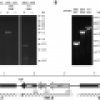Description
Vinegar production requires acetic acid bacteria that produce, tolerate, and conserve high levels of acetic acid. When ethanol is depleted, aerobic acetate “overoxidation” to carbon dioxide ensues. The resulting diauxic growth pattern has two logarithmic growth phases, the first associated with ethanol oxidation and the second associated with acetate overoxidation. The vinegar factory isolate ''Acetobacter aceti'' strain 1023 has a long intermediate stationary phase that persists at elevated acetic acid levels. Strain 1023 conserves acetic acid despite possessing a complete set of citric acid cycle (CAC) enzymes, including succinyl-!CoA:acetate !CoA-transferase (SCACT), the product of the acetic acid resistance (''aar) gene aarC''. In this study, cell growth and acid production were correlated with the functional expression of aar genes using RT-PCR, Western blotting, and enzyme activity assays. Citrate synthase (!AarA) and SCACT (!AarC) were abundant in ''A. aceti'' strain 1023 during both log phases, suggesting the transition to acetate overoxidation was not a simple consequence of CAC enzyme induction. A mutagenized derivative of strain 1023 lacking functional !AarC readily oxidized ethanol but was unable to overoxidize acetate, indicating that the CAC is required for acetate overoxidation but not ethanol oxidation. The primary role of the ''aar'' genes in the metabolically streamlined industrial strain ''A. aceti ''1023 appears to be to harvest energy via acetate overoxidation in otherwise depleted medium.
Cite this work
Researchers should cite this work as follows:
- Mullins, E. A.; T. Joseph Kappock (2013). Figures from Functional analysis of the acetic acid resistance (aar) gene cluster in Acetobacter aceti strain 1023. Purdue University Research Repository. doi:10.4231/D3WH2DF2W
Tags
Notes
Mullins, E. A. and Kappock, T. J. (2013) "Functional analysis of the acetic acid resistance (''aar'') gene cluster in ''Acetobacter aceti'' strain 1023." ''Acetic Acid Bacteria'' 2, e3 (DOI: http://dx.doi.org/10.4081/aab.2013.s1.e3).






